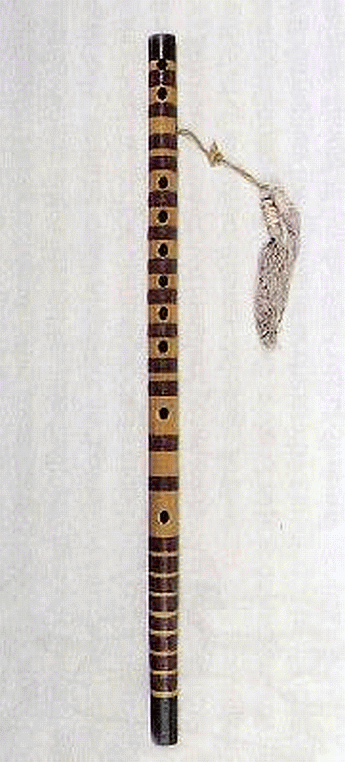 |
||||||||
DiZi has 2 types: Bangdi and Qudi (Sudifor) |
||||||||
  |
The dizi (Chinese: 笛子; pinyin: dízi), is a Chinese transverse
flute. It is also sometimes known as the di (笛) or hengdi (橫笛), and has
varieties including the qudi (曲笛) and bangdi (梆笛).
These names are likely to have multiple spellings, too, depending on the transliteration used to convert from Chinese names. Nonetheless, dizi seems to be the most common name (and written form) used in the West. The dizi is a major Chinese musical instrument, and is widely used in many genres of Chinese folk music, as well as Chinese opera, and the modern Chinese orchestra. Traditionally, the dizi has also been popular among the Chinese common people, and it is simple to make and easy to carry History of Dizi (Bamboo Flute) Dizi, a traditional Chinese musical instrument, became popular as early as the Warring States Period (475-221BC). It first appeared in Hemudu Clan (in present-day Hubei Province) 7,000 years ago. This transverse bamboo flute has a blowing hole, a stop hole and six finger holes. The two holes furthest from the player and fundamental tone holes and next to them are two auxiliary tone holes. Its range is two and a half octaves. During the blossoming of the art of opera in the late Ming (1368-1644) and early Qing (1644-1911) Dynasties, Diziwas adopted as an accompanying instrument for various kinds of stage dramas. There are two basic kinds of Dizi: the Bangdi, which was the shorter one, got its name because it was used to accompany clapper-type operas. It has a strong and piping tone, suitable for expressing robust and lively emotions; Qudi, also named as Sudifor its origin from Suzhou city, is often used to accompany Kunqu Opera. It is five levels lower than Bangdiin pitch. Its tone is pure and mellow, making it suitable for expressing delicate and understated moods. A large number of techniques are used when playing these wind instruments, such as tapping, appoggiatura, tremolo, legato, flower tongue, augment, glide, trill, overtone and prong. Famous Dizi tunes include The Golden Trembling Willows, Audience With the Emperor, Joyous Meeting, Five Clappers, The Partridge Soars, The Bird in the Shade, and Scenic Suzhou. Most dizi are made of bamboo, which explains why dizi are sometimes known by simple names such as "Chinese bamboo flute." However, "bamboo" is perhaps more of a Chinese instrument classification like "woodwind" in the West. Northern Chinese dizi are made from purple or violet bamboo, while dizi made in Suzhou and Hangzhou are made from white bamboo. Dizi produced in southern Chinese regions such as Chaozhou are often made of very slender, lightweight, light-coloured bamboo and are much quieter in tone. Although bamboo is the common material for the dizi, it is also possible to find dizi made from other kinds of kinds of wood, or even from stone. Jade dizi (or yudi, 玉笛) are popular among both collectors interested in their beauty, and among professional players who seek an instrument with looks to match the quality of their renditions; however, jade may not be the best material for dizi since, as with metal, jade may not be as tonally responsive as bamboo, which is more resonant. |
|||||||
The dizi is not the only bamboo flute of China, although it is certainly distinctive. Other Chinese bamboo wind instruments include the vertical end-blown xiao, the guanzi (double reed), the koudi, and the bawu (free reed). Information extracts and image reproduced from Wikipedia under 'Collective Commons License' http://en.wikipedia.org/wiki/Dizi |
||||||||
|
||||||||